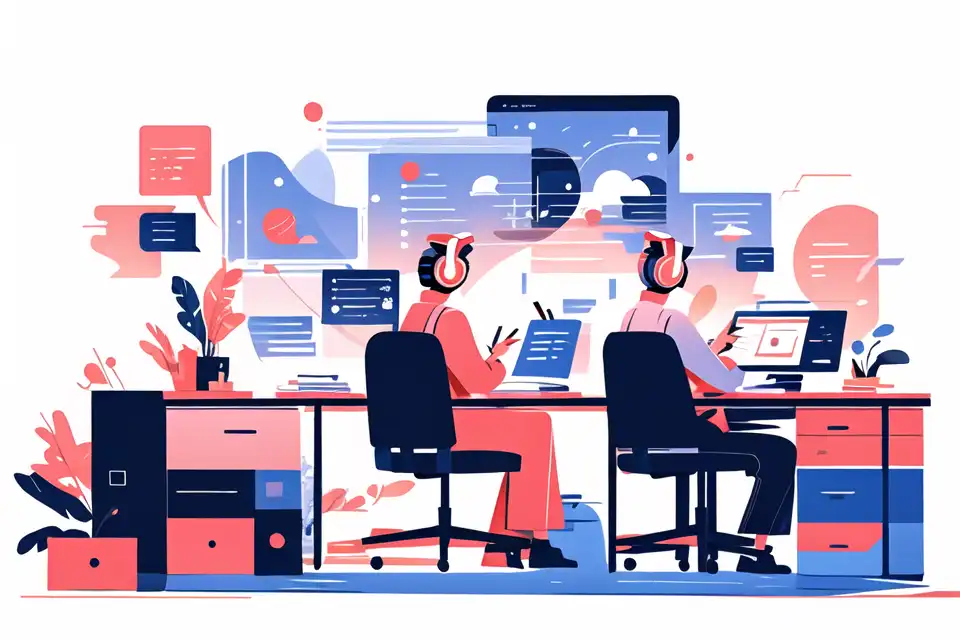Cutscene Creation
Unlock the potential of Cutscene creation with the comprehensive Lark glossary guide. Explore essential terms and concepts to excel in the gaming realm with Lark solutions.
Try Lark for Free
Cutscene creation plays a crucial role in the gaming industry, captivating players and enhancing their overall gaming experience. In this article, we will explore the definition and relevance of cutscene creation, its significance in gaming, and who benefits from it. We will also delve into how cutscene creation works for gaming businesses, including practical implications and best practices for implementation. Additionally, we will provide actionable tips for leveraging cutscene creation in the gaming industry. Finally, we will discuss related terms and concepts and conclude with key takeaways and a FAQ section.
Leverage the full capabilities of Lark Base to streamline, oversee, and successfully execute your real estate strategies and initiatives.
Define cutscene creation and its relevance in the gaming industry
Cutscene creation refers to the process of designing and producing cinematic sequences in video games. These sequences, often non-interactive, serve to advance the game's narrative, provide character development, and create immersive storytelling experiences. Cutscenes can range from pre-rendered videos to real-time rendered sequences that seamlessly transition between gameplay and cinematic elements.
The relevance of cutscene creation in the gaming industry cannot be overstated. For gamers, cutscenes offer a break from gameplay and provide context, emotional engagement, and a sense of progression within the game's storyline. They contribute to the overall enjoyment and immersion, making the gaming experience more captivating and memorable.
From a business perspective, cutscene creation is an essential tool for game developers and publishers. It allows them to showcase their storytelling abilities and create a unique narrative experience that sets their game apart from competitors. Cutscenes can also be used for promotional purposes, enticing potential players with visually stunning and intriguing sequences. Furthermore, cutscene creation can enhance the marketability and commercial success of a game, attracting a larger audience and driving sales.
Significance of cutscene creation in gaming
Understanding cutscene creation is crucial for both gamers and those operating gaming businesses. For gamers, being aware of the intricacies of cutscene creation can deepen their appreciation for the storytelling and artistic elements of a game. It allows them to analyze and critique the quality of cutscenes, enhancing their understanding of the game's narrative and character development.
For gaming businesses, the significance of cutscene creation lies in its potential to elevate the overall quality and appeal of a game. Well-crafted cutscenes can leave a lasting impression on players and generate positive word-of-mouth, leading to increased sales and brand recognition. Moreover, cutscenes can be monetized through additional content such as DLCs (Downloadable Content) or even standalone cinematic experiences, providing additional revenue streams for game developers and publishers.
Who benefits from cutscene creation in gaming
Various stakeholders in the gaming ecosystem benefit from cutscene creation. Game developers and publishers, as mentioned earlier, can leverage cutscenes to enhance the narrative and commercial success of their games. Players benefit from cutscenes by immersing themselves in the game's story and characters, creating a more engaging and emotionally resonant experience. Additionally, voice actors, motion capture artists, and other professionals involved in cutscene creation can showcase their talents and contribute to the overall quality of the gaming industry.
Learn more about Lark x Gaming Industry
How cutscene creation works for gaming businesses
Cutscene creation involves several steps and considerations for gaming businesses. It begins with conceptualizing the narrative and identifying key moments in the game that warrant cutscenes. Next, the script is written, ensuring it aligns with the game's storyline and character development. Once the script is finalized, storyboards or animatics are created to visualize the sequence and plan camera angles, character movements, and other visual elements.
After storyboarding, the production phase begins, involving the creation of assets, such as character models, environments, and special effects. Voice acting and motion capture may also be recorded during this stage. The assets are then animated and rendered, either in real-time or as pre-rendered videos, depending on the game's technical specifications. Finally, the cutscenes are integrated into the game's engine and tested for seamless transitions between gameplay and cinematic elements.
Practical Implications and Why It Matters
Understanding the practical implications of cutscene creation is crucial for gaming businesses. Effective cutscene creation can significantly enhance the overall quality and appeal of a game, resulting in positive reviews, increased player engagement, and higher sales. It is essential to allocate sufficient resources and expertise to the process, ensuring that the cutscenes align with the game's vision and resonate with the target audience.
Furthermore, maintaining a balance between gameplay and cutscenes is vital. Overreliance on cutscenes may disrupt the flow of gameplay and lead to player frustration, while underutilization of cutscenes may result in a less immersive and engaging experience. Striking the right balance requires careful planning and consideration of the game's pacing, narrative structure, and target audience preferences.
Best Practices when Considering Cutscene Creation in Gaming and Why It Matters
Implementing cutscene creation effectively requires adherence to best practices. Here are some key considerations:
-
Seamless Integration: Ensure that cutscenes seamlessly integrate with gameplay, creating a cohesive and immersive experience for players. Avoid abrupt transitions or stark differences in visual style between cutscenes and gameplay.
-
Narrative Cohesion: Maintain narrative cohesion by aligning cutscenes with the overall story arc and character development. Cutscenes should enhance the narrative, providing meaningful context and emotional resonance.
-
Player Agency: Strike a balance between player agency and storytelling in cutscenes. Consider providing interactive elements within cutscenes to maintain player engagement and avoid passive viewing experiences.
-
Visual and Audio Quality: Invest in high-quality visuals, animations, and audio production for cutscenes. Attention to detail and polish can significantly enhance the impact and immersion of cutscenes.
-
Length and Frequency: Consider the length and frequency of cutscenes to avoid overwhelming players or disrupting the gameplay flow. Shorter, well-paced cutscenes that serve a purpose in the narrative are often more effective.
Implementing these best practices can contribute to the overall success and reception of a game, ensuring that cutscenes enhance the player experience rather than detract from it.
Actionable tips for leveraging cutscene creation in the gaming industry
To leverage cutscene creation effectively in the gaming industry, consider the following actionable tips:
-
Create Memorable Characters: Develop well-rounded and relatable characters that players can emotionally invest in. Engaging characters make cutscenes more impactful and enhance the overall storytelling experience.
-
Focus on Cinematic Techniques: Utilize cinematic techniques such as camera angles, lighting, and shot composition to create visually stunning and captivating cutscenes. These techniques can heighten the dramatic impact and immerse players in the game's world.
-
Maintain Consistency: Ensure consistency in art style, tone, and narrative throughout the game, including the cutscenes. Consistency contributes to a cohesive and immersive experience, enhancing player engagement and enjoyment.
-
Test and Iterate: Continuously test and iterate on cutscenes to gather player feedback and refine their effectiveness. This iterative process can help identify areas for improvement and ensure that cutscenes align with player expectations.
By implementing these tips, gaming businesses can maximize the impact of cutscene creation and create memorable experiences for players.
Learn more about Lark x Gaming Industry
Related terms and concepts to cutscene creation in the gaming industry
To further enhance your understanding of cutscene creation in the gaming industry, familiarize yourself with the following related terms and concepts:
Related Term or Concept 1: Interactive Cutscenes
Interactive cutscenes allow players to make choices or perform actions that influence the outcome or progression of the scene. These cutscenes provide a higher level of player agency and engagement.
Related Term or Concept 2: Quick Time Events (QTEs)
Quick Time Events are interactive prompts that appear during cutscenes, requiring players to press specific buttons or perform timed actions to progress the scene. QTEs add a layer of interactivity to cutscenes.
Related Term or Concept 3: In-Engine Cutscenes
In-Engine cutscenes are rendered in real-time using the game's engine, allowing for seamless transitions between cutscenes and gameplay. These cutscenes can adapt to player actions and provide a more immersive experience.
Conclusion
Cutscene creation is a vital aspect of the gaming industry, enhancing the narrative, immersion, and overall quality of games. By understanding the relevance and practical implications of cutscene creation, gaming businesses can leverage this tool effectively to captivate players and drive commercial success. Continuous learning and adaptation in the dynamic gaming landscape are essential to stay at the forefront of cutscene creation and deliver memorable gaming experiences.
Related:
Overcast Games Software Development Service Chooses Lark to Power Effective Team CollaborationLearn more about Lark x Gaming Industry
Leverage the full capabilities of Lark Base to streamline, oversee, and successfully execute your real estate strategies and initiatives.








